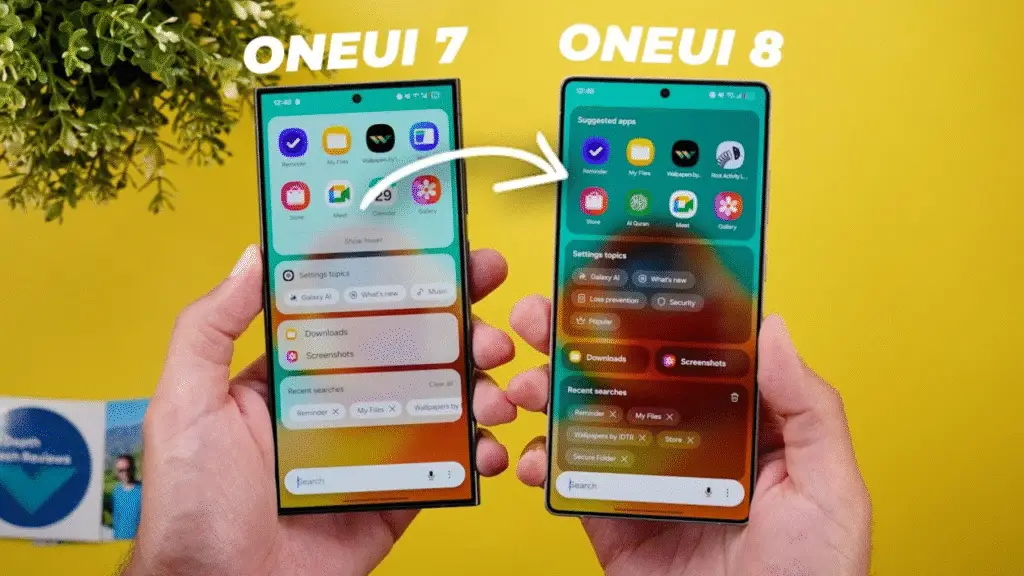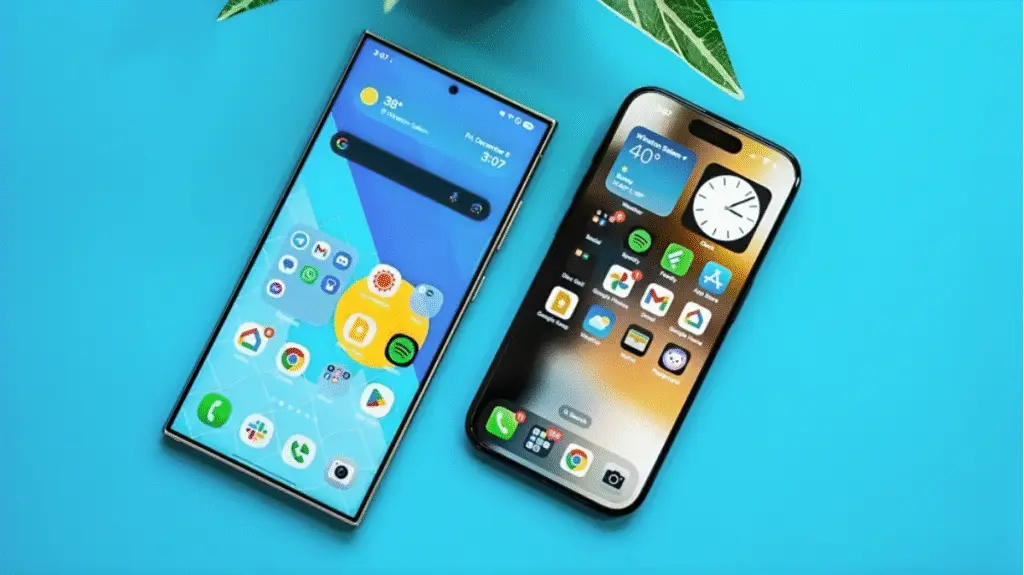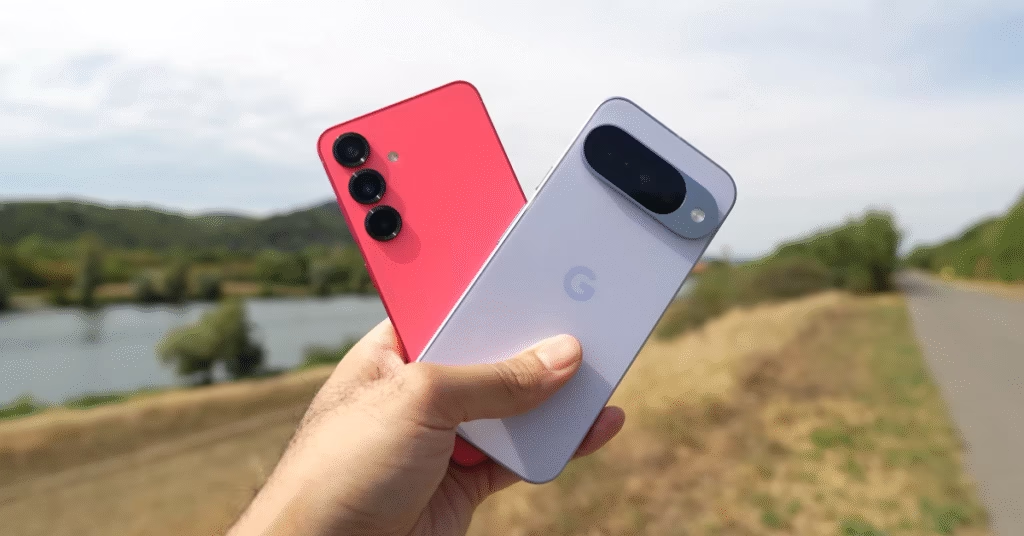
Smartphones in 2025 are more powerful than ever, and this year’s biggest rivalry is between Google’s Pixel 10 and Samsung’s Galaxy S25. Both brands promise smarter cameras, faster performance, and better battery life. But when it comes down to real-world use, how do they actually compare?
This isn’t a lab test, it’s a day spent using both phones side by side: charging them to 100%, hopping on a scooter through the city, taking photos, filming, and seeing which one lasts longer and performs better.
Design and Feel
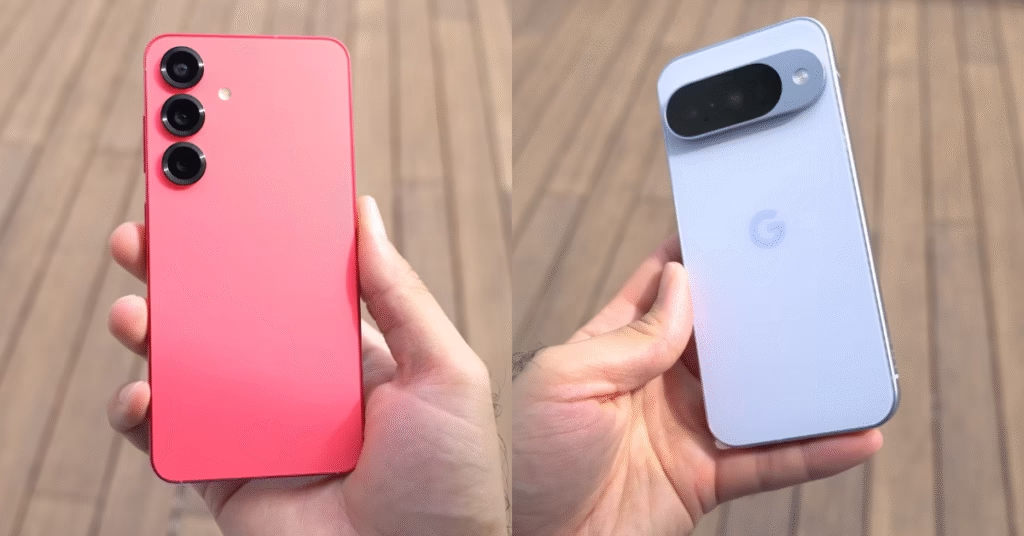
At first glance, both phones look stunning, but they couldn’t feel more different. The Galaxy S25 is light, sleek, and compact at just 162 grams making it one of the lightest flagship phones this year. On the other hand, the Pixel 10 weighs a hefty 204 grams. The extra weight comes from two things: a bigger 4970mAh battery and built-in magnets on the back. These magnets make the phone compatible with Qi2 accessories without needing a case, which is convenient but adds noticeable bulk.
Both phones are beautifully built, the S25 in a striking coral red, and the Pixel in a soft frost shade that gives off a subtle purple hue. But when it comes to ergonomics, Samsung wins simply because it’s easier to hold and lighter in daily use.
Display and Build Quality
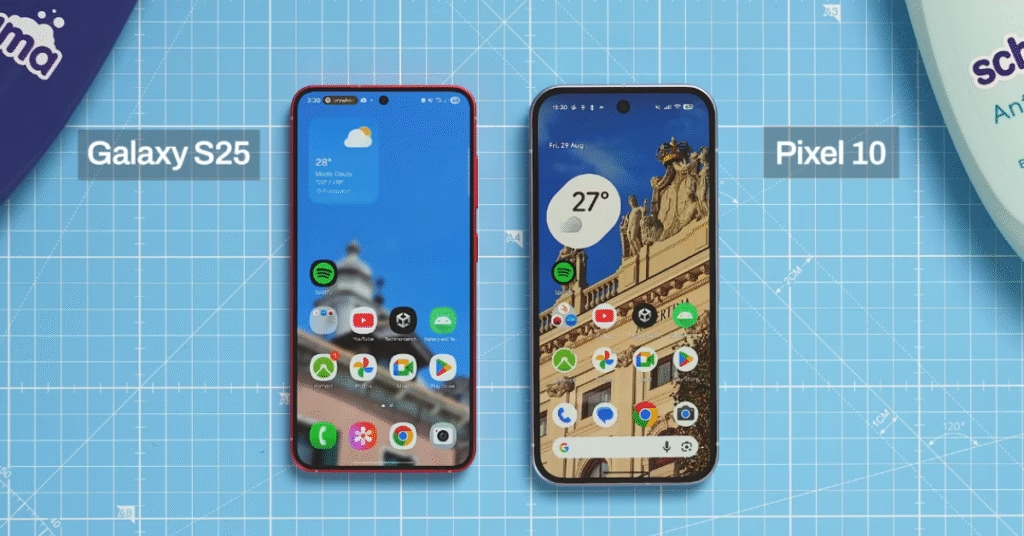
The Galaxy S25 features a 6.2-inch LTPO AMOLED display, while the Pixel 10 has a slightly larger 6.3-inch OLED panel. On paper, they’re nearly identical, but the technology behind the Galaxy’s LTPO panel gives it a major advantage. It can adjust its refresh rate automatically, saving battery during lighter use and providing smoothness when needed.
Brightness and color accuracy are both top-notch on these displays. However, one detail stands out: the Pixel 10 uses a 240Hz PWM frequency, while the Galaxy offers 480Hz. This means the Galaxy’s screen causes less eye strain, especially during long sessions. It’s a small detail, but one that matters more the longer you use your phone.
Performance and Chipset
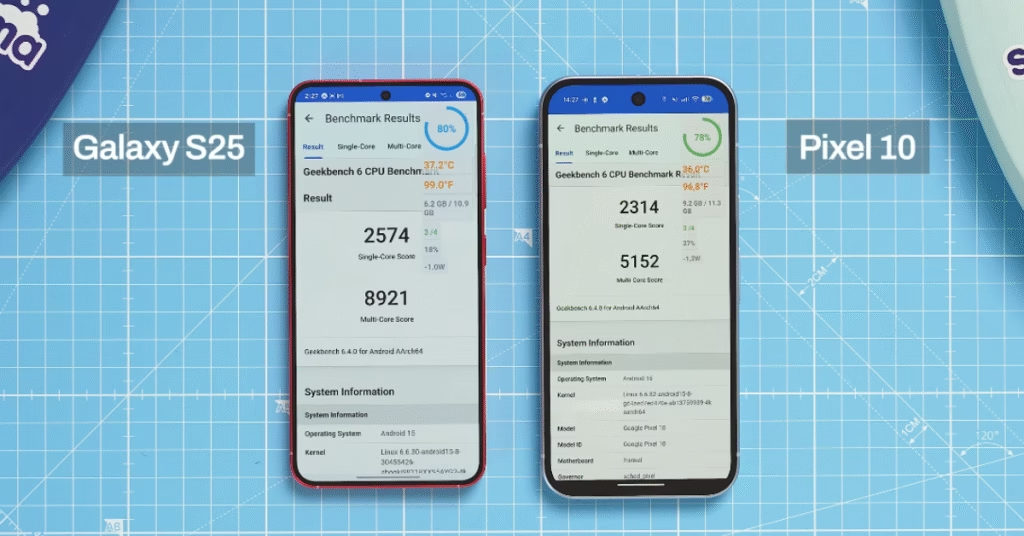
This year marks an interesting shift. Samsung’s Snapdragon 8 Elite (for Galaxy) is currently the fastest Android processor in the world. Google’s Tensor G5, built for the Pixel 10, has finally moved away from Samsung’s foundry and is now produced by TSMC, a big step for efficiency and heat control.
In Geekbench tests, the Galaxy pulls ahead:
- Single-core: (S25) 2574 vs 2314 (Pixel 10)
- Multi-core: (S25) 8921 vs 5152 (Pixel 10)
That’s a huge difference in multi-core performance. Yet in day-to-day tasks opening apps, scrolling, playing music, or light gaming both phones feel equally fluid. The Pixel’s software optimization helps it stay smooth, even without the higher benchmark numbers.
Samsung’s One UI 7 (soon to get version 8) feels rich in features; you get more customization, multitasking tools, and camera settings. The Pixel’s Android 16 is minimal and clean, ideal for those who prefer simplicity and fast updates.
Cameras in the Real World
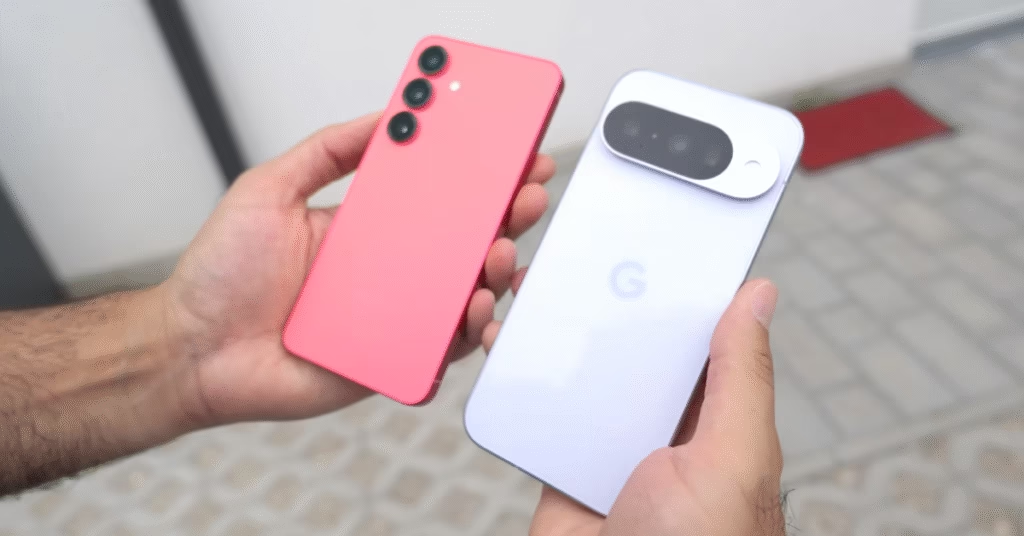
Google finally gave the Pixel 10 a triple camera setup, matching Samsung’s S25 in number but not in sensor size. The Pixel’s main sensor is smaller now, which affects dynamic range and low-light performance.
In daylight photos, both phones perform beautifully; the Pixel tends to produce warmer tones, while the Galaxy’s photos are cooler and slightly more vivid. Food photos pop more on the Galaxy, but the Pixel captures reality more accurately.
When zooming in, the story changes. The Galaxy S25 can zoom up to 30x, while the Pixel 10 caps at 20x. The Pixel 10’s zoom shots, however, sometimes look cleaner thanks to its processing. In low light, though, the Galaxy clearly has the upper hand. Its main sensor captures more detail and color depth, while the Pixel struggles with noise and muddy textures.
Videos tell a similar story. While both phones shoot stable and sharp footage during the day, the Galaxy’s colors and HDR handling look more polished. The Pixel 10’s video often appears a bit flat, especially when recording movement or in darker scenes.
Portrait shots are another surprise; the Pixel limits telephoto zoom to 3x in portrait mode, while the Galaxy handles shadows better and maintains more natural tones. Still, Pixel’s edge detection remains one of the best in the business.
Battery and Efficiency
Both phones started the day fully charged, connected to 5G, and running GPS tracking through Komoot. As the hours passed navigating, taking photos, and streaming YouTube the differences began to show.
By mid-day, both were around 90% battery, but after heavier camera use and video recording, the Galaxy stayed just a touch ahead. By evening, the S25 was at 29%, while the Pixel was at 34%.
On paper, the Pixel has the advantage with its 4970mAh battery versus Samsung’s 4000mAh. But thanks to the Galaxy’s LTPO display and better chipset efficiency, it performs almost identically in endurance. Both phones gave around 4 hours and 12 minutes of screen-on time during a busy test day. Overnight standby also leaned slightly toward the Pixel, which drained less while idle.
Heat management was surprisingly similar. The Pixel 10 stayed cool throughout, a clear improvement over its predecessors that were known for thermal issues.
Software and User Experience
Both phones bring something unique. The Galaxy S25 feels mature Samsung’s One UI is polished, packed with features, and lets you do more without needing third-party apps. The Pixel 10, meanwhile, feels pure and simple. You get updates first, less bloatware, and an interface that stays consistent across years.
For Android developers or users who want to experience the newest features first, the Pixel remains unbeatable. But for someone who values customization, multi-window tools, and added functionality, Samsung’s ecosystem still leads the way.
Verdict
After spending a full day with both devices, the results are surprisingly balanced.
The Pixel 10 finally brings a triple camera system and a bigger battery, but it also gets heavier and loses some of the image quality edge it once had. The main camera sensor downgrade and limited video quality make it a tough sell for photographers. On the bright side, Google’s AI tricks, cleaner software, and magnetic Qi2 support make it a solid everyday choice.
The Galaxy S25, on the other hand, may not have the biggest battery, but its lightweight design, LTPO screen, and Snapdragon 8 Elite chip make it a powerhouse of efficiency. The camera system remains consistent, video performance is stronger, and the screen comfort (thanks to higher PWM) is noticeably better for long use.
In short if you want pure Android and prefer Google’s ecosystem, the Pixel 10 won’t disappoint. But if performance, design, and overall refinement matter more, the Galaxy S25 still feels like the more balanced flagship.
FAQs (Pixel 10 vs Galaxy S25)
Which phone has the better camera, Pixel 10 or Galaxy S25?
Both phones deliver exceptional camera performance, but in slightly different ways. The Pixel 10 focuses on realistic colors and excellent AI photo processing, while the Galaxy S25 offers a richer, more vibrant tone with advanced zoom capabilities. If you prefer true-to-life images, go with the Pixel; for eye-catching, social media–ready shots, the Galaxy takes the edge.
Does the Pixel 10 perform better than the Galaxy S25 in gaming?
The Galaxy S25, powered by theSnapdragon 8 Gen 4, offers smoother gameplay and better heat management. The Pixel 10’s Tensor G4 chip is capable but more tuned for AI tasks and efficiency than pure gaming power. Hardcore gamers will likely favor the Galaxy.
Which display looks better in daily use?
Samsung still leads in display technology. The Galaxy S25’s Dynamic AMOLED panel offers richer contrast and slightly higher brightness outdoors. The Pixel 10’s OLED screen is excellent for everyday use, though it feels more muted compared to Samsung’s punchy visuals.
How about battery life? Which one lasts longer?
Battery performance is close, but the Galaxy S25 tends to last a bit longer thanks to optimization with the Snapdragon 8 Gen 4. The Pixel 10, however, recharges faster and uses adaptive software to extend endurance over time.
Which phone offers better software support?
Both promise long-term updates. Google provides direct Android updates for up to seven years, giving the Pixel 10 a slight edge in timing and stability. Samsung matches that commitment, but Pixel users usually get the updates first.
Is the Galaxy S25 worth the higher price?
If you want the latest hardware, premium build, and better gaming and display performance, then yes. The Galaxy S25 justifies its price. But if you value clean Android experience, AI features, and more budget-friendly pricing, the Pixel 10 delivers excellent value.
Which phone should I buy overall?
It depends on what matters most to you. The Pixel 10 is ideal for users who love Google’s software ecosystem, smart AI tools, and simple yet elegant performance. The Galaxy S25, on the other hand, is a powerhouse with stunning visuals, faster performance, and a more luxurious feel.
See Also Google Pixel 10 Pro XL vs Samsung S25 Ultra: Battle of the 2025 Flagships
